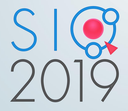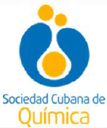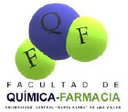Executive Secretary

VII Simposio Internacional de Química 2019
SIQ 2019
Chagas Disease is wide spread through the population in Latin American, affecting around 15 million of people. This illness has been regarded as neglected, since its prevalence is only significant in developing countries. Current therapies are inefficient and a plausible solution is only possible through academic research. The parasitic protozoa responsible for this disease is Trypanosoma cruzi. Trypanothione Reductase (TR) is the main detoxification enzyme of this parasite and it has been identified as a drug target. In silico methods, such as molecular docking, are valuable tools for predicting the binding capacity of newly designed compounds to enzymes, such as TR. Here we performed molecular docking simulations of 250 tetrazole-thiadiazine-2-thione hybrids in order to identify potential inhibitors of TR. The tetrazole moiety was incorporated in the structures due to its previously reported pharmacological properties. The simulations were performed using AutoDock Vina 1.1.2. Our results suggested that 5 compounds can be potential inhibitors of Trypanothione Reductase. The introduction of bulky and aromatic substituents in the structure of the compounds increases the interactions with the TR active site. Additionally, we exploited the advantage of the multicomponent reaction in the design of our novel hybrids. A methodology, comprising two multicomponent processes, was established for the synthesis of the desired compounds, in around 40% yield after three reaction steps. These new compounds were characterized by NMR-1H and 13C.
Chagas Disease is wide spread through the population in Latin American, affecting around 15 million of people. This illness has been regarded as neglected, since its prevalence is only significant in developing countries. Current therapies are inefficient and a plausible solution is only possible through academic research. The parasitic protozoa responsible for this disease is Trypanosoma cruzi. Trypanothione Reductase (TR) is the main detoxification enzyme of this parasite and it has been identified as a drug target. In silico methods, such as molecular docking, are valuable tools for predicting the binding capacity of newly designed compounds to enzymes, such as TR. Here we performed molecular docking simulations of 250 tetrazole-thiadiazine-2-thione hybrids in order to identify potential inhibitors of TR. The tetrazole moiety was incorporated in the structures due to its previously reported pharmacological properties. The simulations were performed using AutoDock Vina 1.1.2. Our results suggested that 5 compounds can be potential inhibitors of Trypanothione Reductase. The introduction of bulky and aromatic substituents in the structure of the compounds increases the interactions with the TR active site. Additionally, we exploited the advantage of the multicomponent reaction in the design of our novel hybrids. A methodology, comprising two multicomponent processes, was established for the synthesis of the desired compounds, in around 40% yield after three reaction steps. These new compounds were characterized by NMR-1H and 13C.
Sobre el ponente

Javier Alfonso

Student at faculty of chemistry





